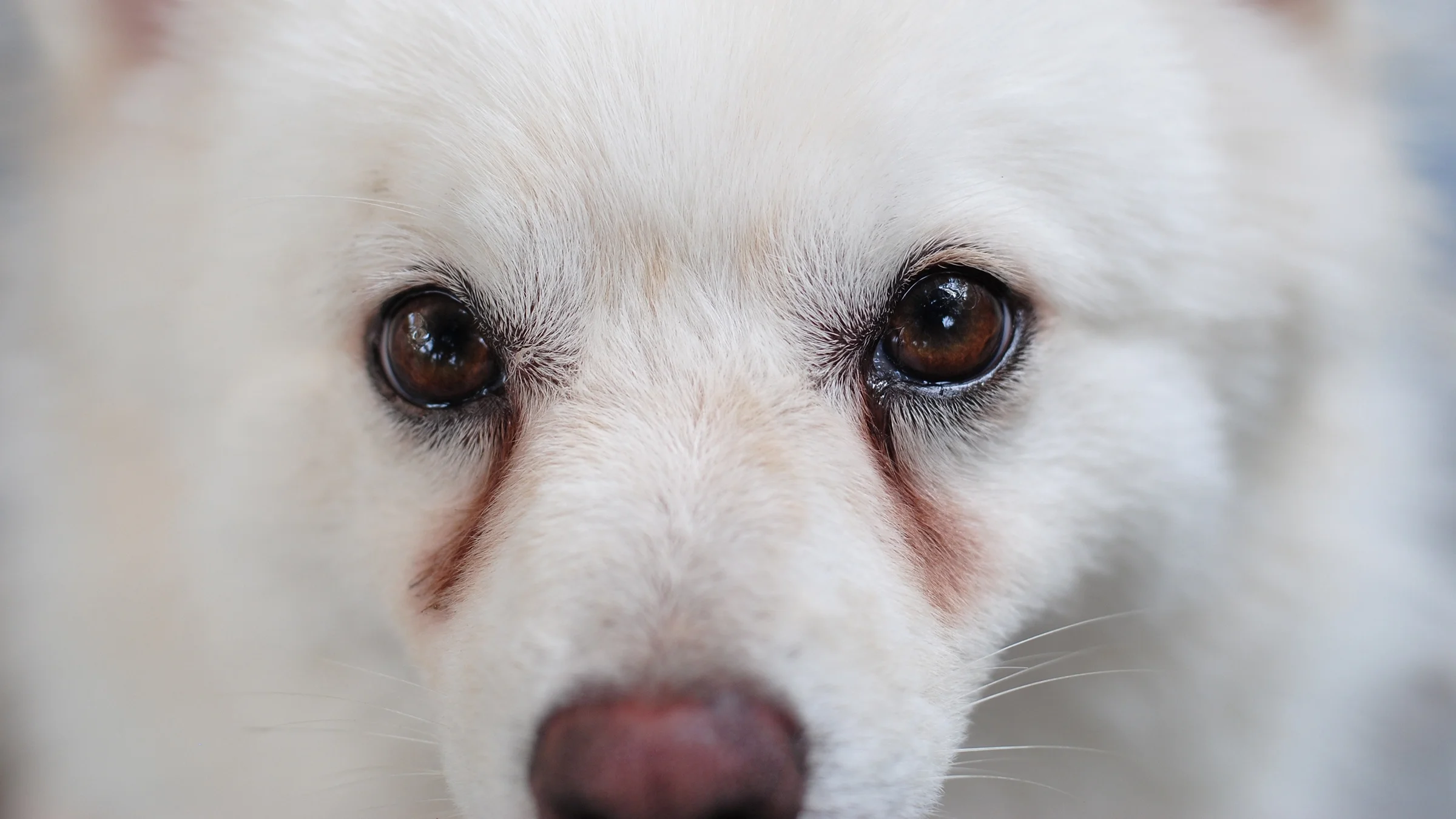Key takeaways:
Tear stains are caused by a chemical in dogs’ tears that stains their fur brown, light pink, or red.
There are many ways you can remove and prevent tear stains, including by focusing on thorough grooming and using commercially available tear-stain-removal products.
Several underlying factors can cause tear stains, including the shape of a dog’s face, allergies, ingrown eyelashes, and plugged tear ducts.
If your dog has lighter-colored fur, you may notice stains traveling from the corners of their eyes down to around their nose. These stains could be minor or pretty dramatic, depending on your dog’s case. Tear stains aren’t painful for your dog, but it can be frustrating to see their beautiful fur discolored.
There are several potential causes of tear stains. But once you understand what’s causing your dog’s issue, you can better remove and prevent future stains.
How can you remove your dog’s tear stains?
You can remove tear stains in several ways. Below, we look at three ways to manage tear staining on dogs. But it’s helpful to have a veterinarian evaluate your dog’s tear stains so that you know if treatment is needed to address the cause.
Search and compare options
1. Treat medical conditions
Before you start trying to remove tear stains yourself, schedule an appointment with a veterinarian. If your dog’s tear stains are caused by a medical condition, like an ingrown eyelash or allergies, then it’s important to treat that condition. This will prevent stains from reoccurring.
“The best way to remove and prevent tear stains is to treat the underlying condition if possible,” Chyrle Bonk, DVM, told GoodRx Health.
2. Use tear-stain-removal products
“There are a variety of products out there targeted at removing tear stains,” Bonk said. “These products come in the form of wipes, solutions, or shampoos.”
Tear-stain-removal products gently clean and eliminate stains. Some products are made with all-natural ingredients like vitamins, minerals, and plant extracts. And these are often a good choice for puppies or dogs with sensitive skin. There are also medicated products that may help reduce irritation and inflammation.
Bonk also said that you may be able to use a warm washcloth and a mild baby shampoo to gently remove stains. “Just make sure to thoroughly rinse out any soap,” she said.
3. Avoid irritating products
As you work to remove your dog’s tear stains, be sure to avoid using any products that could further irritate their eyes. For example, you might find tips online for removing tear stains with the products below. But these items should always be avoided:
Makeup remover
Milk of magnesia
Yogurt
Honey
Hydrogen peroxide
Gold Bond
Cornstarch
How often should you groom your dog? Get expert grooming tips by breed and fur type.
How much do dog X-rays cost? Here’s what to expect and how to save on canine imaging.
How do you manage inflammation in dogs? Learn about prednisolone, a steroid that controls inflammation and autoimmune reactions in dogs.
When applied around your dog’s eyes, these products can be highly irritating. Instead, stick to products designed specifically for tear stains, or products a veterinarian has recommended.
What causes tear stains in dogs?
A chemical called porphyrin causes tear staining in dogs. Porphyrins are organic compounds that stain the fur light pink, red, or brown.
Your dog naturally excretes porphyrins through their intestinal tract, tears, saliva, and urine. That’s why if your dog is white, you may have noticed a brownish stain on their leg after they lick themselves. That stain is caused by the porphyrins in your dog’s saliva.
All dogs excrete porphyrins, but some dogs are more likely to have tear stains. Below are a few common reasons your dog may have tear staining.
A lighter-colored coat
When dogs produce excessive tears, porphyrins in the tears can stain their face. The staining is particularly noticeable in dogs with lighter-colored coats.
Certain features
Tear staining can occur simply because of a dog’s natural features. Short noses and protruding eyes are common features of today’s dog breeds. Dogs with that face shape typically have narrow tear ducts, and those ducts are often crooked. That naturally leads to tear staining.
Eyelid problems
Tear staining can also result from an eyelid issue, Bonk said.
“Tear staining is often the result of an abnormality in the eyelids that allows tears to drain down a dog’s face, rather than into their [tear duct],” she said. “[Tear staining] can be due to a plugged duct or excessive looseness or tightness of the lower lid.”
Environmental or physical issue
Other physical and environmental issues can lead to excessive tear production and staining, including:
Allergies
Ingrown eyelashes
Irritants like cigarette smoke
Which dog breeds are more prone to tear stains?
Certain breeds are more likely to experience tear staining than others, Bonk said. “Tear staining often occurs in brachycephalic breeds, or those breeds with short, smooshed faces,” she said. “This is due to their facial structure.”
This includes dogs like:
Boxers
Bulldogs
Pugs
Boston terriers
Other breeds that “are also prone to tear staining,” Bonk said, include:
Shih tzus
Lhasa apsos
Maltese
Poodles
Pekingese
How to prevent tear stains on dogs
You may be able to help prevent your dog from developing tear stains in the first place by taking the following steps.
Keep your dog’s face groomed
To prevent tear stains, focus on keeping your dog’s face well-groomed. Wipe their face twice a day with a damp cloth, and schedule regular appointments with the groomer. Careful grooming can help keep your dog’s eyes from getting irritated and quickly addresses and removes tear stains that are starting to form.
Avoid using plastic food and water bowls
Use only food and water bowls made from stainless steel, porcelain, or glass. Plastic food bowls can develop tiny cracks that harbor bacteria. This bacteria can irritate your dog’s face, leading to increased tear production.
Feed them a nutritious diet
Your dog’s diet may also be important for preventing tear stains. Providing your dog with high-quality, balanced nutrition may help keep their face free of stains.
Frequently asked questions
We don’t know which food ingredients may cause tear staining in dogs. There’s not a lot of research on dog-food ingredients causing tear stains. Feed your dog a nutritious diet and talk to a veterinarian if you suspect your dog’s food contributes to staining.
Groomers use a variety of tear-stain removers, such as wipes, cleansers, and eye rinses. Ask your dog’s groomer for recommendations.
A saltwater or saline solution may help rid your dog of tear stains. But ask a veterinarian before trying this on your dog. Trying to do this at home without guidance can lead to you damaging your dog’s eyes and causing a lot of pain.
We don’t know which food ingredients may cause tear staining in dogs. There’s not a lot of research on dog-food ingredients causing tear stains. Feed your dog a nutritious diet and talk to a veterinarian if you suspect your dog’s food contributes to staining.
Groomers use a variety of tear-stain removers, such as wipes, cleansers, and eye rinses. Ask your dog’s groomer for recommendations.
A saltwater or saline solution may help rid your dog of tear stains. But ask a veterinarian before trying this on your dog. Trying to do this at home without guidance can lead to you damaging your dog’s eyes and causing a lot of pain.
The bottom line
Dog tear stains can be frustrating — and you may not like the look of them — but they aren’t painful for your dog. If your dog frequently develops tear stains, it’s best to talk with a veterinarian to rule out underlying physical issues, such as allergies or an ingrown eyelash. From there, you can come up with a plan to remove and prevent tear stains, which might include focusing on thorough grooming and using a tear-stain-removal product.

Why trust our experts?



References
Brooks, W. (2023). Runny eyes (epiphora) in dogs. Veterinary Partner.
Destefanis, S., et al. (2017). Clinical evaluation of a nutraceutical diet as an adjuvant to pharmacological treatment in dogs affected by epiphora. International Journal of Applied Research in Veterinary Medicine.
Hamor, R. E. (2024). Nasolacrimal and lacrimal apparatus in animals. Merck Veterinary Manual.
The People’s Dispensary for Sick Animals. (2019). Tear staining in dogs.
Plummer, C. E. (2015). Addressing brachycephalic ocular syndrome in the dog. Today’s Veterinary Practice.
Smithfield Animal Hospital. (n.d.). A veterinary guide to stubborn tear stains on dogs.
Wright, C., et al. (2018). Microbiological assessment of canine drinking water and the impact of bowl construction material. 69th Annual Meeting of the European Federation of Animal Science.














